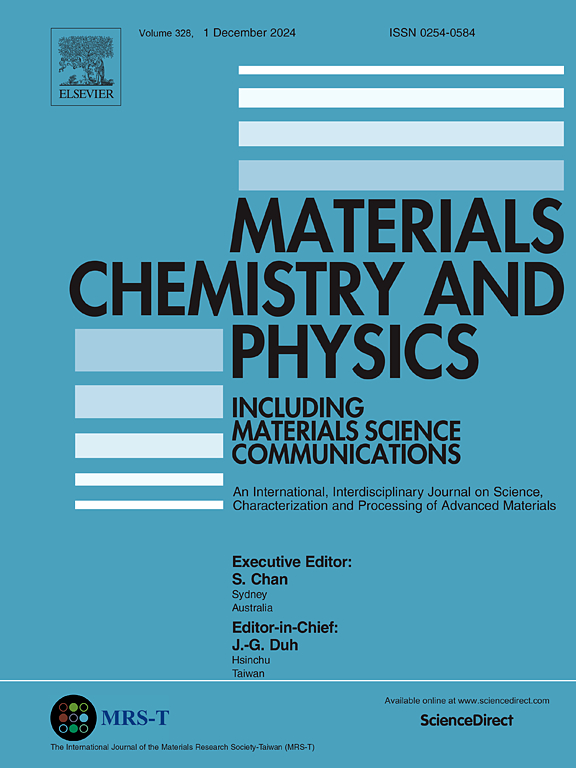Excellent energy storage and high stability achieved in lead free BZT-SrBiT ceramics synthesized via conventional solid state method
IF 4.3
3区 材料科学
Q2 MATERIALS SCIENCE, MULTIDISCIPLINARY
引用次数: 0
Abstract
Ferroelectrics are recognized as some of the most advanced dielectric energy storage capacitors, thanks to their exceptional ability to achieve high electric polarization yields. This unique property enables them to store and release energy efficiently, making them ideal for various applications in electronics and energy systems. Their advanced performance positions them at the forefront of energy storage technology. This characteristic exceeds that of their linear counterparts, making them pivotal in advancing the compactness and lightweight design of electric power systems. Yet, within the realm of ferroelectrics lies a complex challenge: striking a balance between energy density and a spectrum of other indispensable properties. Among these, energy efficiency, temperature and frequency stabilities, and resistance to cycling fatigue reign paramount. Navigating these intricate dynamics is imperative for unlocking the full potential of ferroelectrics in practical applications. In this study, we focus on domain engineering as a method to manipulate the structure of materials by fragmenting them into polar nano regions. This strategic approach aims to enhance energy efficiency while maintaining high energy density levels. Our investigation centers on the utilization of the BZT-SrBiT (x = 0.6 & 0.7), lead-free solid-solution system as a representative example to illustrate this concept. Our findings impressively demonstrate a substantial energy density of 2.92 J/cm3, accompanied by an efficiency rating of 80.13 %. This accomplishment underscores our strategy's effectiveness in enhancing energy storage capabilities while preserving performance metrics. It reflects our dedication to advancing technology that meets the growing demands of the market without sacrificing quality or efficiency. Additionally, the system exhibits remarkably narrow hysteresis loops, indicating minimal energy loss during polarization reversal. Additionally, across a broad spectrum of temperatures and frequencies ranging from 40 °C to 150 °C and 1Hz, respectively, the high energy density of 4.46 J/cm3 and efficiency of 80.13 % at an electric field strength of 150 kV/cm exhibit marginal variations of only ±3 % to ±5 %. This methodology holds promise for the development of ferroelectrics across a diverse range of material systems, each boasting commendable energy storage capabilities. Furthermore, this approach allows us to achieve a discharge energy density of 5.1 J/cm3 within a rapid duration of 5.66 μs, along with an exceptional efficiency rating of 86.5 %. These findings open up a novel avenue for developing foundational components tailored for pulse power capacitors, paving the way for potential commercialization efforts.
采用传统固相法合成的无铅BZT-SrBiT陶瓷具有优异的储能性能和高的稳定性
铁电体是公认的一些最先进的介电储能电容器,由于其特殊的能力,实现高电极化率。这种独特的特性使它们能够有效地存储和释放能量,使其成为电子和能源系统中各种应用的理想选择。它们的先进性能使它们处于储能技术的前沿。这一特性超过了它们的线性对应物,使它们在推进电力系统的紧凑和轻量化设计方面发挥关键作用。然而,在铁电体领域中存在着一个复杂的挑战:在能量密度和其他不可或缺的特性之间取得平衡。其中,能源效率、温度和频率稳定性以及抗循环疲劳是最重要的。驾驭这些复杂的动力学对于释放铁电体在实际应用中的全部潜力至关重要。在这项研究中,我们将重点放在领域工程上,作为一种通过将材料分割成极性纳米区域来操纵材料结构的方法。这一战略方针旨在提高能源效率,同时保持高能量密度水平。我们的研究集中在BZT-SrBiT (x = 0.6 &;0.7),无铅固溶体系为代表的例子来说明这一概念。我们的研究结果令人印象深刻地证明了2.92 J/cm3的能量密度,伴随着80.13%的效率等级。这一成就强调了我们的战略在提高储能能力的同时保持性能指标的有效性。这反映了我们致力于在不牺牲质量或效率的情况下推进技术以满足日益增长的市场需求。此外,该系统表现出非常窄的磁滞回线,表明极化反转过程中的能量损失最小。此外,在40°C至150°C和1Hz的宽温度和频率范围内,在电场强度为150 kV/cm时,高能量密度为4.46 J/cm3,效率为80.13%,边际变化仅为±3%至±5%。这种方法有望在各种材料系统中开发铁电体,每种材料系统都具有值得称赞的储能能力。此外,这种方法使我们能够在5.66 μs的快速持续时间内实现5.1 J/cm3的放电能量密度,以及86.5%的卓越效率。这些发现为开发适合脉冲功率电容器的基础组件开辟了一条新的途径,为潜在的商业化努力铺平了道路。
本文章由计算机程序翻译,如有差异,请以英文原文为准。
求助全文
约1分钟内获得全文
求助全文
来源期刊

Materials Chemistry and Physics
工程技术-材料科学:综合
CiteScore
8.70
自引率
4.30%
发文量
1515
审稿时长
69 days
期刊介绍:
Materials Chemistry and Physics is devoted to short communications, full-length research papers and feature articles on interrelationships among structure, properties, processing and performance of materials. The Editors welcome manuscripts on thin films, surface and interface science, materials degradation and reliability, metallurgy, semiconductors and optoelectronic materials, fine ceramics, magnetics, superconductors, specialty polymers, nano-materials and composite materials.
 求助内容:
求助内容: 应助结果提醒方式:
应助结果提醒方式:


